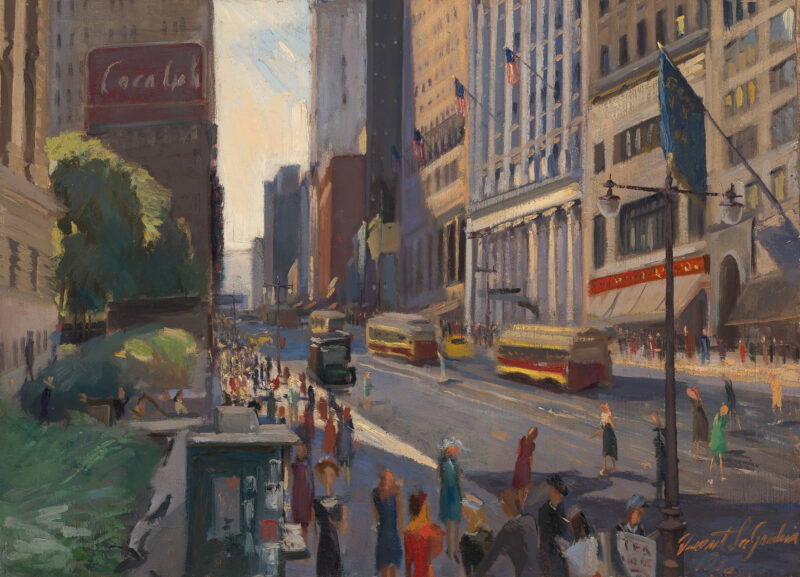
Forty Second Street, New York City
La Gambina, Vincent
1938
Artwork Information
-
Title:
Forty Second Street, New York City
-
Artist:
La Gambina, Vincent
-
Artist Bio:
American, 1909–1994
-
Date:
1938
-
Medium:
Oil on canvas
-
Dimensions:
18 1/8 x 25 1/8 inches
-
Credit Line:
Wichita Art Museum, Gift of the artist
-
Object Number:
1988.21
-
Display:
Not Currently on Display
About the Artwork
Vincent La Gambina was born in Agrigento, Sicily, and came to New York in 1920 at age eleven. The young immigrant was orphaned shortly after and was left homeless. Eventually he was able to support himself as an artist; he made his first sale at fifteen, while still a student at the Leonardo Da Vinci Art School, to New York Mayor Fiorello La Guardia. La Gambina also studied at the National Academy of Design. During the Depression he was employed by the teaching, easel, and mural divisions of the Federal Art Project of the WPA. After serving in the army, he studied on the GI Bill at the Art Students League with Sidney Dickinson, Frank DuMond, and Ivan Olinsky. In the 1940s he taught at his own Washington Square Art School.
Forty Second Street, New York City depicts mid-town Manhattan looking west from Fifth Avenue down Forty-Second Street.1 On the far-left side of the picture, the striated surface pierced with windows represents the north wall of the New York Public Library. The lush greenery beyond it indicates Bryant Park, a large public area that had been redesigned in 1934. Forty-second Street, a dramatic diagonal tunnel of receding space bathed in golden afternoon sunlight, dominates the composition, and strongly contrasts with the shady left side of the painting. The light emanates from the unseen open space of the park and flows over the uppermost branches of the dark green trees on its way to the north side of the street.
A particularly luminous triangular patch at the edge of the street parries the larger triangular shape created by the one-point perspective. The sidewalks bustle with colorful figures but are not overly crowded on this warm summer day; pedestrians crossing the street, most women, stroll bare-armed. Four American flags and a blue banner displayed on the buildings, along with the light traffic in the street, may indicate that this is a Fourth of July holiday scene. The artist’s point of view is slightly above street level, undoubtedly from an elevated terrace that runs across the east-facing front of the library and extends beyond the library wall seen in the painting. A photograph by Berenice Abbott taken from the northeast side of the same intersection shows the terrace and also the newspaper kiosk that is located in the foreground of La Gambina’s painting, as well as the library wall and the park.2 Abbott’s photograph, entitled Tempo of the City, was taken on 6 September 1938, the same year that La Gambina painted this canvas. Abbott was photographing a series of views of New York City for the Federal Art Project when she created this image, so it seems possible that La Gambina’s work may have been done at the time that he was working for the easel division of the same program. Rather than the massed humanity of Abbotts photograph, La Gambina offers the viewer a relaxed, spacious perspective of the city on a beautiful day.
- My thanks to Dr. John Pultz for identifying the location of this scene.
- Reproduced in Berenice Abbott, New York in the Thirties (New York: Dover Publications, Inc., 1973), plate 62.